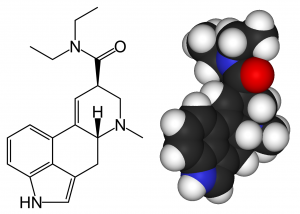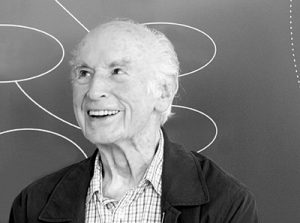Slice of PLOS: Psychedelics in the Lab and Clinic: Making Up for Lost Time
Nearly 50 years ago, psychiatrists lost access to one of the most promising tools they’d found to study consciousness and treat a range of refractory psychological conditions: psychedelic drugs. Psychedelics were banned in the United States in 1970 and by the United Nations the next year, classified as Schedule I drugs with a “high potential for abuse” and “no currently accepted medical use.” Many scientists blame Timothy Leary, the Harvard psychologist who became one of the most prominent psychedelic proselytizers of the sixties, for fueling both the drug’s popularity and the media frenzy that inevitably triggered a legal backlash [1].

These restrictions have severely impeded research into novel therapies to treat brain disorders. As British psychiatrist David Nutt argued in PLOS Biology a few years ago [2], “Most researchers do not have the time, money, or energy to work through the regulatory jungle.” And with no federal support for this work, scientists must rely on private organizations like the Multidisciplinary Association for Psychedelic Studies (MAPS) and the Beckley Foundation, which funds Nutt’s group at the Neuropsychopharmacology Unit in the Division of Brain Sciences at Imperial College London. Both organizations are dedicated to breaking the bureaucratic logjam.
Last month, Nutt joined hundreds of other clinicians and researchers who’ve received private funding to pursue psychedelic medicine and research at the third MAPS-sponsored Psychedelic Science 2017 conference in Oakland, California.
Scientists and clinicians presented evidence from ongoing research suggesting that psychedelics, used in a controlled psychotherapy setting, have the potential to alleviate conditions that don’t respond to conventional drugs and therapy, including depression, social anxiety, post-traumatic stress disorder and addiction. Some are harnessing psychedelics to study the neural basis of consciousness, using advanced imaging techniques to map changes in brain activity and chemistry to altered perception, moods and perspective.
Much of the recent work with psychedelics picks up where early psychiatric pioneers left off, in many cases confirming what researchers hypothesized but lacked the tools to test.
Early evidence of positive results
Clinicians started experimenting with LSD in the late 1940s, soon after Albert Hofmann, the Swiss chemist who first synthesized the drug while studying the ergot fungus as a potential medicine, accidentally dosed himself. Hofmann reported an “extraordinary disturbance” marked by “an uninterrupted stream of fantastic images of extraordinary plasticity and vividness and accompanied by an intense, kaleidoscope-like play of colors.”

Credit: Stepan Wikimedia Commons
The potential of this mind-altering drug was not lost on Hofmann, and psychiatrists soon began experimenting with psychedelics to treat addiction, obsessive-compulsive disorders, depression and anxiety. Some used LSD to model the delusions and psychosis seen in schizophrenia, while others explored its “mind loosening” effects to help patients work through repressed thoughts and feelings. Experimental psychiatrist Joel Elkes took LSD with a small group of volunteers in 1952, the first to do so in England. He noted in a retrospective commentary that observations from these experiments led him to propose that the drug selectively inhibited the organization of sensory information through a serotonin-mediated receptor.
Elkes was “remarkably prescient,” Nutt says, “because that’s what we have shown.”
Historians of psychedelic science say that by the mid-1960s researchers had published over 1,000 clinical studies involving over 40,000 patients, reporting few side effects, though many of the studies would not meet contemporary research standards. Even so, Leary’s promotion of LSD as a panacea for the unenlightened masses, many scientists say, led regulators to slam the door on research that held great promise for unlocking the mysteries of the mind.
Despite a “lack of accepted safety” designation that goes along with a Schedule I classification, most studies have found no evidence that psychedelics produce serious adverse effects when used under controlled conditions. That may hold for recreational use as well, according to a 2012 PLOS ONE study, which found no indication of psychological problems in healthy people who used LSD, psilocybin, peyote or mescaline [3]. Another PLOS ONE study came to the same conclusion about ayahuasca, a psychedelic tea brewed from bark and leaves traditionally used as part of ritual healing ceremonies in the Amazon Basin [4].The research doesn’t claim that adverse events can’t happen. But they are likely rare and in some cases may be related to pre-existing conditions.
Placebos, probes and treatments
Early studies of psychedelics typically failed to use controls, raising an obvious question: how do you design a placebo-controlled trial when the active drug under study produces profound changes in perception and cognition?
It helps to work with people who’ve never experienced the drug before so they don’t know what to expect, says Fernanda Palhano-Fontes, a PhD student working in Draulio Barros de Araujo’s lab at the Brain Institute at the Universidade Federal do Rio Grande do Norte in Brazil. In a recent study to test ayahuasca’s potential to alleviate treatment-resistant depression, she and her colleagues used a placebo brew designed to mimic the potent tea’s color and nasty taste, and even its capacity to cause nausea.

Credit: Sascha Grabow, Wikimedia Commons
Participants were randomly assigned to receive a placebo or a single dose of ayahuasca and, as often happens in depression trials, both groups improved somewhat the next day. But by the end of the week, people in the ayahuasca group showed much greater gains than the placebo group. The study, which involved just 35 patients, hasn’t been published yet (but is available on bioRxiv [5]).
To better understand how ayahuasca affects mood and perception, Palhano-Fontes and Araujo have been studying its effects on the brain in healthy people, using fMRI. They reported in a 2015 PLOS ONE paper [6] that ayahuasca caused reduced activity in what’s known as the default mode network, a “connector hub” of brain regions that tends to be more active when people are resting or daydreaming. It’s been associated with sense of self, and emotional and cognitive processing. Studies have associated increased activity in this network with schizophrenia, depression, social phobia and several other psychiatric conditions. This increased activity has also been linked to intense rumination and obsessive thoughts. One theory holds that by suppressing the default mode network, psychedelics may help release the brakes on severely constrained thinking, opening the door to more effective psychotherapy.
For David Nutt, psychedelics hold a unique capacity to probe the neurobiology of mental states, and to reprogram circuits to recover from psychological distress. “These drugs can change your attitude to life,” Nutt says. In a study of psilocybin-assisted therapy for depression, he found that patients became less pessimistic. “My outlook has changed significantly,” one patient said. “I’m more aware now that it’s pointless to get wrapped up in endless negativity.”
Stanislav Grof, a Czech psychiatrist who conducted clinical trials with LSD before it was illegal, once said, “Psychedelics, used responsibly and with proper caution, would be for psychiatry what the microscope is for biology and medicine or the telescope is for astronomy.”
But that promise won’t be realized until regulators change the restrictions on psychedelics and recognize their potential as a medicine. Hofmann immediately recognized that psychedelics release constraints on consciousness to offer a glimpse into a world we otherwise can’t perceive. Now scientists have the tools to figure out how psychedelics do that by interrogating the underlying brain mechanisms in a reproducible, scientifically valid way — if only we let them.
Credit for featured image: Psilocybe zapotecorum from Michoacan, Mexico, by Alan Rockefeller via Wikimedia Commons.
Further reading
[1] Moreno, J. D. (2016) Acid Brothers: Henry Beecher, Timothy Leary, and the psychedelic of the century.” Perspectives in Biology and Medicine, vol. 59 no. 1, pp. 107-121. Project MUSE, doi:10.1353/pbm.2016.0019
[2] Nutt D (2015) Illegal Drugs Laws: Clearing a 50-Year-Old Obstacle to Research. PLoS Biol 13(1): e1002047. https://doi.org/10.1371/journal.pbio.1002047
[3] Krebs TS, Johansen P-Ø (2013) Psychedelics and Mental Health: A Population Study. PLoS ONE 8(8): e63972. https://doi.org/10.1371/journal.pone.0063972
[4] Bouso JC, González D, Fondevila S, Cutchet M, Fernández X, Ribeiro Barbosa PC, et al. (2012) Personality, Psychopathology, Life Attitudes and Neuropsychological Performance among Ritual Users of Ayahuasca: A Longitudinal Study. PLoS ONE 7(8): e42421. https://doi.org/10.1371/journal.pone.0042421
[5] Rapid antidepressant effects of the psychedelic ayahuasca in treatment-resistant depression: a randomised placebo-controlled trial (2017) Fernanda Palhano-Fontes, Dayanna Barreto, Heloisa Onias, Katia C Andrade, MorganaNovaes, Jessica Pessoa, Sergio Mota-Rolim, Flavia L Osorio, Rafael Sanches, Rafael dos Santos, Luis Tofoli, Gabriela Silveira, Mauricio Yonamine, Jordi Riba, Francisco RRSantos, Antonio A Silva-Junior, Joao Alchieri, Nicole Galvao-Coelho, Brunoj Lobao-Soares, Jaime Hallak, Emerson Arcoverde, Joao Maia-de-Oliveira, Draulio B de Araujo
bioRxiv 103531; doi: https://doi.org/10.1101/103531
[6] Palhano-Fontes F, Andrade KC, Tofoli LF, Santos AC, Crippa JAS, Hallak JEC, et al. (2015) The Psychedelic State Induced by Ayahuasca Modulates the Activity and Connectivity of the Default Mode Network. PLoS ONE 10(2): e0118143. https://doi.org/10.1371/journal.pone.0118143

[…] Slice of PLOS: Psychedelics in the Lab and Clinic: Making Up for Lost Time – PLoS Blogs (blog) […]
[…] passa giorno che nuovi dati non vengano pubblicati su riviste specializzate per approfondire la ricerca sulle proprietà degli […]